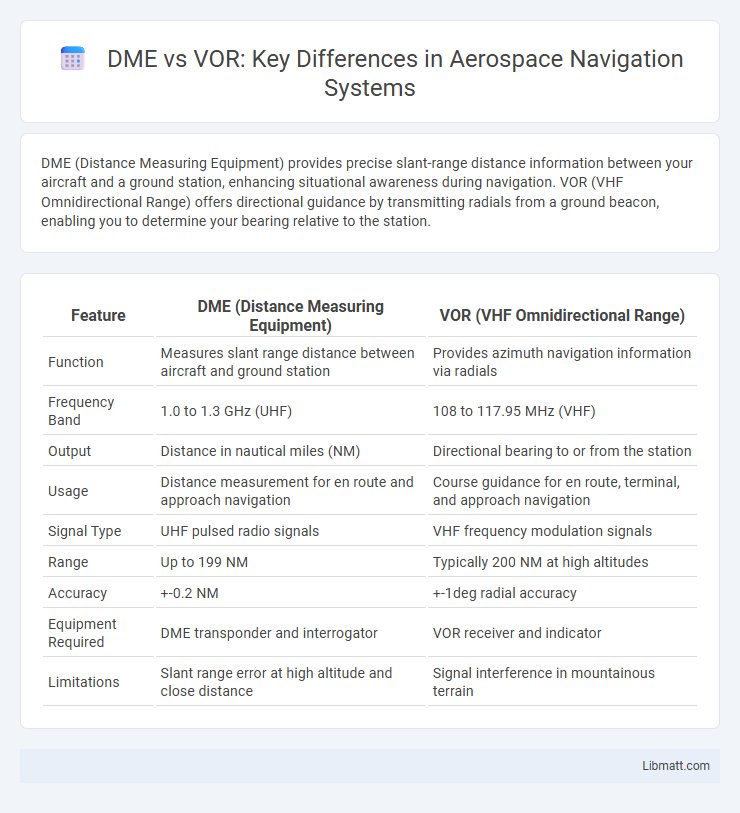DME (Distance Measuring Equipment) provides precise slant-range distance information between your aircraft and a ground station, enhancing situational awareness during navigation. VOR (VHF Omnidirectional Range) offers directional guidance by transmitting radials from a ground beacon, enabling you to determine your bearing relative to the station.
Table of Comparison
| Feature | DME (Distance Measuring Equipment) | VOR (VHF Omnidirectional Range) |
|---|---|---|
| Function | Measures slant range distance between aircraft and ground station | Provides azimuth navigation information via radials |
| Frequency Band | 1.0 to 1.3 GHz (UHF) | 108 to 117.95 MHz (VHF) |
| Output | Distance in nautical miles (NM) | Directional bearing to or from the station |
| Usage | Distance measurement for en route and approach navigation | Course guidance for en route, terminal, and approach navigation |
| Signal Type | UHF pulsed radio signals | VHF frequency modulation signals |
| Range | Up to 199 NM | Typically 200 NM at high altitudes |
| Accuracy | +-0.2 NM | +-1deg radial accuracy |
| Equipment Required | DME transponder and interrogator | VOR receiver and indicator |
| Limitations | Slant range error at high altitude and close distance | Signal interference in mountainous terrain |
Introduction to DME and VOR
DME (Distance Measuring Equipment) provides pilots with precise slant range distance information from an aircraft to a ground station, enhancing situational awareness during navigation. VOR (VHF Omnidirectional Range) offers azimuth data by transmitting signals that allow your aircraft to determine its bearing relative to the station. Together, DME and VOR enable accurate en-route navigation and instrument approaches by combining distance and directional guidance.
Definitions: What is DME?
Distance Measuring Equipment (DME) is a radio navigation technology used in aviation that determines the slant range distance between an aircraft and a ground station by measuring the time delay of radio signals. Unlike VOR, which provides directional information to pilots by indicating aircraft bearing relative to a VOR station, DME specifically offers precise distance information. Your navigation system integrates DME to enhance accuracy during approaches, en route navigation, and holds.
Definitions: What is VOR?
VOR (VHF Omnidirectional Range) is a type of short-range radio navigation system that allows aircraft to determine their position and stay on course by receiving radio signals transmitted by a network of ground-based fixed radio beacons. These beacons emit signals in the VHF frequency range between 108.00 and 117.95 MHz. VOR aids pilots in en route navigation and instrument approaches by providing bearing information relative to the station.
Key Differences Between DME and VOR
DME (Distance Measuring Equipment) provides accurate slant distance information between an aircraft and a ground station, aiding in precise navigation. VOR (VHF Omnidirectional Range) offers azimuth guidance by transmitting radials that pilots use to determine their bearing relative to the station. Your navigation relies on VOR for directional information, while DME complements this by supplying real-time distance data to enhance situational awareness and flight accuracy.
How DME Works in Aviation Navigation
Distance Measuring Equipment (DME) operates by sending an ultra-high frequency radio signal from the aircraft to a ground-based transponder, which then responds with a reply signal that allows the aircraft to calculate slant range distance. This measurement provides pilots with accurate real-time distance information from the DME station, essential for en-route navigation and instrument approaches. Compared to VOR, which offers directional guidance based on azimuth, DME supplies precise distance data, enhancing situational awareness and flight path accuracy.
How VOR Works in Aviation Navigation
VOR (VHF Omnidirectional Range) operates by transmitting two signals: a constant reference phase and a variable phase that rotates 30 times per second. Aircraft receivers measure the phase difference between these signals to determine the radial or bearing from the station, allowing pilots to navigate along specific airways. This system provides precise azimuth information within a range typically up to 200 nautical miles, essential for en-route navigation and instrument approaches.
Advantages and Limitations of DME
DME (Distance Measuring Equipment) provides precise slant-range distance measurements between an aircraft and a ground station, enhancing navigation accuracy beyond what VOR (VHF Omnidirectional Range) offers. Unlike VOR, which only offers azimuth information, DME allows pilots to determine their exact distance, improving situational awareness and aiding in approach procedures. However, DME signals are subject to line-of-sight limitations and can be affected by terrain and altitude, restricting its effectiveness in certain environments compared to the broader coverage of VOR.
Advantages and Limitations of VOR
VOR (VHF Omnidirectional Range) offers precise azimuth information and widespread coverage, making it highly reliable for aircraft navigation during enroute and terminal phases. Its advantages include simplicity, cost-effectiveness, and compatibility with aircraft navigational systems, but it is limited by signal line-of-sight, susceptibility to signal interference, and less accuracy at long distances compared to DME (Distance Measuring Equipment). Your navigation benefits from VOR's ability to provide bearing information, but reliance on it alone may not offer distance measurement, which is why combining VOR with DME is common in aviation for comprehensive situational awareness.
Practical Applications: DME vs VOR in Flight Operations
DME provides precise distance information from a ground station, enhancing situational awareness during en-route navigation and instrument approaches. VOR offers azimuth guidance, allowing pilots to determine their bearing relative to the station for accurate course tracking and position fixing. Your flight operations benefit from combining both systems, as using VOR for directional guidance and DME for distance measurement ensures efficient and safe navigation.
Future Trends and Technological Developments
DME technology is evolving with advancements in satellite-based augmentation systems (SBAS) and integration with GPS, enhancing accuracy and reliability for navigation. VOR systems face gradual phase-out plans as the aviation industry shifts towards performance-based navigation (PBN) and next-generation GNSS solutions. Emerging trends emphasize digital data link improvements and the incorporation of Artificial Intelligence for predictive maintenance and optimized route planning in both DME and VOR infrastructures.
DME vs VOR Infographic

 libmatt.com
libmatt.com